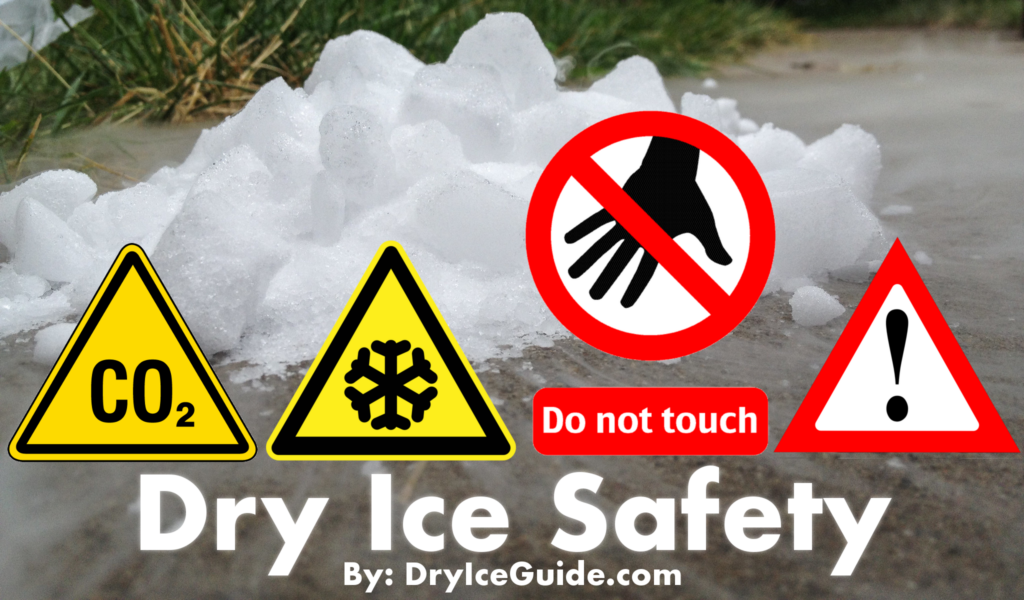
So you have bought your pack of dry ice and are ready to use it. Great, now what? – you may ask. How do you get started with handling it and what exactly is safe and what’s not? These are some vital questions you better get the answer to before even beginning.
This is what we aim to provide you with in this article. Everything you ought to know on the safe handling of dry ice.
In general, dry ice can be a very dangerous and even deadly (!) substance if not given the proper attention it requires. It is incredibly cold, but that is just half of the hazard. Dry ice is technically the solid form of carbon dioxide, a toxic gas which can suffocate humans if proper ventilation is not carried out.
Can you touch dry ice?

No. You cannot touch dry ice with your bare hands!
Due to the extreme surface temperature of the substance, touching dry ice is only possible with necessary protective equipment. This can be thick gloves or multiple layers of towels or dish cloths. Even exposing your skin for a few seconds to it can result in frostbite, possibly severe.
Frostbite is the freezing of the skin and tissues below it and can have multiple levels of severity – according to Mayo Clinic. The most serious type is called ‘deep frostbite’ and can cause permanent skin damage and intense pain. Early on you experience the change of skin color to a blueish or whiteish hue, loss of sensation, but after warming it up again it doesn’t go away. Your skin turns black and hard lastingly in the area where it was injured. Dry ice can cause this deep frostbite, so please do not touch it with bare hands.
If you have an accident, seek medical attention immediately.
Is dry ice toxic?

It can be if held in an area without proper ventilation.
Sadly, there still are a couple of news stories every year about deaths relating to dry ice. In February 2020, for example, 3 people died at an influencer’s pool party in Moscow after organizers dumped 25 kg of dry ice into the water causing people to start choking and lose consciousness.
As mentioned in the introduction, dry ice is the solid form of CO2. One of the most important properties of it is that it doesn’t take a liquid form under normal pressure levels. It goes from solid to gas in a process called sublimation bypassing the liquid phase. The warmer the air surroiunding dry ice, the more gas it releases.
The physiological effects of CO2 include hypoxia which is when the body doesn’t get enough oxygen. Hypoxia can lead to seizures, coma or even death in severe instances.
Importance of ventillation
A case report by Smith Srisont, M.D. et al. in a forensic science journal documented an instance of a person dying from hypoxia related to bad ventilation and gasses from dry ice sublimation. In this specific case, a person hid in a 50 cubic foot container which unfortunately had some dry ice in it. The victim was found dead after just a couple of minutes.
The report is the one of many articles that highlight the importance of proper ventilation when using dry ice. This should have special emphasis if transporting dry ice in a confined vehicle (car) or using it indoors. In these situations, proper airing may not be given so some extra measures are imperative.
It is also important to be aware that carbon dioxide is heavier than air so it sinks to the ground. This means it is vital to make measures to protect our pets or small children, even in well ventilated areas!
If you have breathing difficulties or suspect an increased amount of CO2 in the air, leave the space with dry ice and get fresh air immediately. You should call your local emergency services, or go to an emergency room if symptoms worsen.
Can you eat dry ice?
No, absolutely not. It is possibly the most dangerous thing you can do with it!
The ingestion of dry ice is the combination of the two most prominent risks associated with it laid out in the previous sections. As it is perilously cold, coming in contact with your mouth, throat, gullet and stomach it could cause irreversible damage to them by freezing their tissues.
If eaten, the CO2 released in the stomach could increase pressure and possibly rupture the organ leading to serious injury or death – according to Anna Marie Helmenstein, M.D. of ThoughtCo.
Image source:
- Glove image: Lily_M